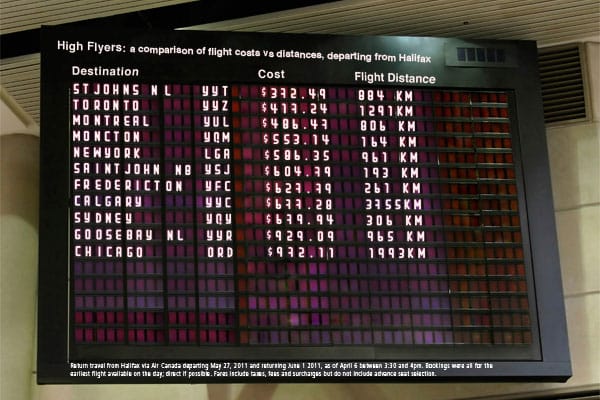How pricey flights in Atlantic Canada affect our economy—and our people.
Summer and Christmas are the most popular times for many Atlantic Canadians to make a pilgrimage home. For Meghan Perry, the route is rugged, the costs dear. Originally from Churchill Falls, in Labrador, Perry moved to Halifax in 2005 to study at Dalhousie University. Now working to become a chartered accountant, she continues to make a trip home to Labrador each December. From Halifax, Perry flies to Happy Valley-Goose Bay, then drives three hours over a partially paved road to Churchill Falls, a town of about 600.
Yet the drive over a ragged road isn’t the jarring part of Perry’s journey home. The real pain is the cost of flying to Labrador in the first place: somewhere between $1,000 and $1,500 during the holiday season, Perry says.
“If the price was cheaper I would definitely go home more often,” says the 23-year-old.
Such is life on the East Coast, where flights can often seem outrageously expensive. Pair high airfares with out-migration from rural areas to regional cities and beyond, and you have an Atlantic Canadian diaspora singing the high, lonesome blues.

“Travelling to Atlantic Canada presents challenges in itself. Then you start travelling within the region and the costs become astronomical,” says Stelman Flynn, who runs the Seaview Restaurant and Cabins, in Forteau, Southern Labrador.
Located on the Strait of Belle Isle, across from the northern tip of Newfoundland, Forteau offers nature lovers views of whales, dolphins and seabirds during summer months. The small com- munity also serves as a gateway to the mountainous terrain and salmon-filled rivers that await visitors in Labrador.
But it’s a potentially expensive decision to visit the isolated land. A round-trip ticket from St. John’s to a small airport near Forteau costs between $600 and $850, Flynn notes, a tidy sum considering an all-inclusive week in the Caribbean sun can cost less than $1,000.
“The costs are prohibitive,” Flynn says. “It’s just too expensive for the travelling public to fly within this province. I don’t have the solution, but obviously competition is one way of dealing with it,” he continues. “That said, it’s challenging to own an airline today and to provide service to rural parts of this country… The solution is not an easy one.”
Labrador is clearly an extreme case when it comes to air travel and fares: it’s a large, rural and sparsely populated area where the demand for flights is relatively low. Yet Labrador tourism operators are not unique in their struggles with costly airfares in Atlantic Canada.
“The regional prices are right through the roof,” says Réal Robichaud, executive director of the Tourism Industry Association of New Brunswick. “Price is always the dark cloud hanging over our head.”
In New Brunswick, airfares impact the province’s ability to attract conventions and conferences, Robichaud says. New Brunswick cities can be overlooked in favour of larger centres with more air access and cheaper routes.
“There are an awful lot of stumbling blocks here. If it’s not cost, it’s the availability of flights,” Robichaud says. “They’re both barriers to us being competitive… At the end of the day, travellers are saying, ‘To heck with it, I’ll use other means or not go.’”
Costly ticket prices are affecting more than just incoming traffic in New Brunswick. Just ask David Innes, the president and CEO of the Fredericton International Airport.
Innes estimates that a full third of US-bound travellers in his region actually drive to New England airports to catch cheap flights to American destinations, particularly Florida. The result: thousands of New Brunswick passengers funnelling money into the US economy.
“The high cost of flying in Canada is really a detriment to our economy,” Innes says.
The cross-border bleed to American airports is a national issue, and one fuelled by governments’ relentless taxing of the air travel industry, Innes argues, adding that Canadian governments pull $1 billion from the country’s air transportation system each year through various taxes and fees.
For instance, in 2009 the country’s 15 largest airports paid more than $280 million in rent to Transport Canada—equal to $10 per passenger. American airports, Innes notes, have no corresponding fee. Similarly, Canadian airports must pay property tax, while their US counterparts do not.
Unlike US airline tickets, Canadian tickets are also priced to cover fuel taxes and fees paid to NAV Canada, which provides air traffic control and flight information, Innes says. And then there’s the HST charged on airline tickets, which nets the New Brunswick government an estimated $10 million a year.
“Our governments have become a burden to our aviation system and view it as a cash cow… The Americans view the aviation system as a vital part of their community’s economic and social infrastructure,” Innes wrote in the Fredericton Daily Gleaner last year.
“These contrasting visions have led us to this point, where the costs within Canada’s aviation system are too high, our fares are too expensive, and we are uncompetitive.”
In Atlantic Canada, airlines serve a relatively small population spread over four provinces, further impacting the cost of air travel. And then there’s the issue of competition among carriers in the region.
“Obviously that’s the reason why we have higher prices—there are very few players in the market here,” says Leanne Hachey, who flies extensively throughout the region as the Atlantic vice-president of the Canadian Federation of Independent Business. “High airfare is one of the costs of doing business in Atlantic Canada.”
Perhaps, but the region’s coverage by major airlines is improving, argues Monette Connaughton, executive director of the Atlantic Canada Airports Association. According to Connaughton, East Coast airports have worked aggressively in recent years to lure more carriers to Atlantic Canada. Porter Airlines, for example, has added a third option—in addition to Air Canada and WestJet—for travellers flying to central Canada from Halifax, Moncton and St. John’s.
Access to international flights has also increased. In 2005, Atlantic Canada had only one daily, year-round flight to the US. Today, there are year-round daily flights from Halifax to New York, Newark, NJ, Washington, DC, Chicago, Philadelphia and Boston. Moncton and St. John’s are also linked to Newark with direct, year-round flights. And even Charlottetown has a direct flight to New York during the summer. Plus, Halifax is connected to Europe with year-round service to London’s Heathrow Airport, along with seasonal flights to Frankfurt and Paris
“We have far more carriers than we did in the past. As far as pricing goes, it’s always a challenge and something we have to work on,” Connaughton says, from her Charlottetown office.
“The more competition there is… the better prices are going to be.”
Back in Newfoundland and Labrador, the provincial government has taken an active role in trying to reduce airfares and attract new flights. Last fall the government released a five-year strategy aimed at spurring demand, ensuring “reasonable” prices, and adding more direct and frequent flights to, from and within the province.
To do so, the government pledged $4 million to help airlines and the province’s airports promote their routes and develop new ones. Late last year, a provincial director of Air Access was hired to oversee those efforts.
Airfares may eventually drop in Newfoundland and Labrador, though for now Meghan Perry is not overly optimistic. “It’s frustrating but I’m used to the price. I doubt it’s going to change anytime soon.” If it does, Perry says she’ll venture home to Churchill Falls more than once a year. She’d like to see her family and hometown friends more often, and visit her favourite haunts like Blueberry Lake, where she swam and fished as a child.
“I miss my home. It’s small, but it’s my home.”
